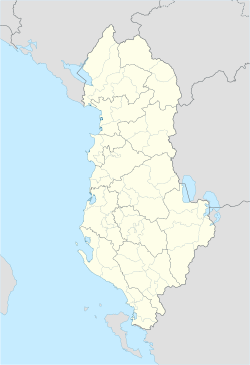Muzinë (Albanian definite form: Muzina, Greek: Μουζίνα), is a village of the administrative unit of Mesopotam, Finiq, southern Albania.[2] The village is known for its proximity to the water spring known as the Blue Eye, a popular tourist attraction.
Muzinë
Μουζίνα | |
|---|---|
| Coordinates: 39°55′N 20°12′E / 39.917°N 20.200°E | |
| Country | |
| County | Vlorë |
| Municipality | Finiq |
| Municipal unit | Mesopotam |
| Time zone | UTC+1 (CET) |
| • Summer (DST) | UTC+2 (CEST) |
| Postal Code | 9717[1] |
The population of Muzinë is composed of Orthodox Albanian speakers from the late Ottoman period till the late twentieth century.[3][4][5] In the twenty first century, although Albanian is the main village language, inhabitants themselves self identify as Greek speakers and some as Greek.[6] Muzinë has undergone extensive depopulation due to the migration of its younger population, and in the early 2020s most of its remaining inhabitants are elderly.[7]
History
editA school was established in the village by Greek Orthodox missionary Cosmas of Aetolia (18th century). Greek education was expanded during the late Ottoman era with the establishment of a female school.[8]
In the late Ottoman period, Muzinë was an Albanian speaking village.[3]
During World War II, anti-fascist forces enjoyed tremendous support in Muzinë.[9] From the local anti-fascist forces 35 members were from this village, 7 of which were women.[9] A very large number given its population. The village was bombed on January 14, 1944 by Nazi German forces and almost completely destroyed.[9] Of the 141 houses in the village of Muzina, 138 were blown up with explosives.[9] The village school, one of the largest in the area, was burned down.[9] About 800 head of livestock, beehives, and hundreds of fruit trees were also destroyed.[9]
Muzinë was a Christian Albanian speaking village in the 1960s.[4] Marriages occurred from among its population and with a neighbouring Albanian speaking village, a few with the surrounding Greek speaking villages and inhabitants and none with the neighbouring Greek speaking region of Dropull.[4]
In fieldwork done by Leonidas Kallivretakis in 1992, Muzinë together with Pecë were two villages of the former Mesopotam commune inhabited solely by an Albanian Orthodox population, while the Greek community of Albania inhabited the other villages of the commune.[5]
In 1994, folklorist Fatos Rrapaj recorded from Muzinë locals in Sarandë that the village consisted of the following families: Çiko, Dede, Dardeli, Diamanti, Dumani, Gabici, Gogo, Gjika, Gjino, Koça, Kongo, Konomi, Kotori, Kroti, Kumbe, Lako, Lula, Maneli, Moko, Mitrojorgji, Murxhi, Naçi, Nathanaili, Nika, Prifti, Rumano, Vathi, Verli and Xhuhani.[10]
In the early 2010s, Muzinë's population had substantially decreased due to demographic and migration factors.[6] Although Albanian is the first language used, villagers self-identify as Greek speakers and Orthodox when asked.[6] Muzinë inhabitants hold differing and complex views about Greek or Albanian identity, and villagers who describe themselves as Greek see no clash with an allegiance to Albania.[6] People in Muzinë are bilingual, fluent in both Greek and Albanian and speak either language.[6] Greek is used for religious matters, music, well wishes and interactions with Greek speakers, while Albanian is the main language of Muzinë and the youth usually speak it at home.[6]
Muzinë's population consists of 70 elderly people in the early 2020s.[7] Most houses are abandoned and only forty houses remain inhabited.[7] Due to immigration of the youth to urban centres or abroad, a lack of students has resulted in closure of the school.[7]
Muzinë is among the villages in which members of the ethnic Greek minority reside and are recognized as such by the Albanian authorities.[11]
References
edit- ^ "Kodi Postar, Sarandë" [Postal Code, Sarandë] (PDF). Posta Shqiptare. 2017.
- ^ "Law nr. 115/2014" (PDF) (in Albanian). p. 6376. Retrieved 25 February 2022.
- ^ a b Kokolakis, Mihalis (2003). Το ύστερο Γιαννιώτικο Πασαλίκι: χώρος, διοίκηση και πληθυσμός στην τουρκοκρατούμενη Ηπειρο (1820–1913) [The late Pashalik of Ioannina: Space, administration and population in Ottoman ruled Epirus (1820–1913)]. Athens: EIE-ΚΝΕ. p. 52. ISBN 960-7916-11-5. "και κάποιες ακόμη μεμονωμένες γλωσσικές νησίδες (τα αλβανόφωνα χωριά της Δρόπολης Φραστανή και Μουζίνα"
- ^ a b c de Rapper, Gilles; Sintès, Pierre (February 2008). Faire et défaire les frontières du mariage. Échanges matrimoniaux entre la Grèce et l'Albanie: le cas de la région de Gjirokastër. Vivre et tracer les frontières dans les mondes contemporains. Tangier: Centre Jacques Berque. pp. 3–4. Retrieved 4 February 2022.
- ^ a b Kallivretakis, Leonidas (1995). "Η ελληνική κοινότητα της Αλβανίας υπό το πρίσμα της ιστορικής γεωγραφίας και δημογραφίας" [The Greek Community of Albania in terms of historical geography and demography]. In Nikolakopoulos, Ilias; Kouloubis, Theodoros A.; Veremis, Thanos M. (eds.). Ο Ελληνισμός της Αλβανίας [The Greeks of Albania]. University of Athens. ISBN 9789600800548. p. 51. "ΑΧ Αλβανοί Ορθόδοξοι Χριστιανοί"; p.55. "PECA ΠΕΤΣΑ 166 ΑΧ", "MUZINA ΜΟΥΖΙΝΑ 197 ΑΧ"
- ^ a b c d e f Brown, Christopher G.; Joseph, Brian D. (2013). "The Texture of a Linguistic Environment: New Perspectives on the Greek of Southern Albania". Albanohellenica. 5: 147.
- ^ a b c d "Fshati Muzinë po mbetet bosh, banorët e moshuar vuajnë mungesën e shërbimeve" (in Albanian). Ora News. 11 April 2021. Retrieved 7 February 2022.
- ^ Koutsou, Elsa. "Schools of the Greek Minority of Albania". University of Ioannina. p. 19. Retrieved 18 February 2021.
Χάλιου, Συρακάτες Μουζίνα και Σενίτσα: Είχαν κοινά σχολεία που συστήθηκαν από τον Κοσμά τον Αιτωλό, η δε Μουζίνα είχε και Παρθεναγωγείο
- ^ a b c d e f Koçi, Bashkim (28 May 2019). "Muzina, "Hiroshima" shqiptare" (in Albanian). Gazeta Telegraf. Retrieved 19 February 2021.
- ^ Rrapaj, Fatos Mero (1995). Fjalori onomastik i epirit (in Albanian). Eurorilindja. pp. 441, 444.
- ^ Kouzas, Ioannis (2013). "The Greek-Albanian Relations (1990-2010)" (in Greek). Δημοκρίτειο Πανεπιστήμιο Θράκης (ΔΠΘ). Σχολή Νομική. Τμήμα Νομικής. Τομέας Διεθνών Σπουδών. pp. 93–95. Retrieved 18 February 2021.
Από τις αλβανικές αρχές επίσημα αναγνωρίζονται ως ελληνικά τα παρακάτω χωριά... Επαρχία Μεσοποτάμου: 2. Μουζίνα
